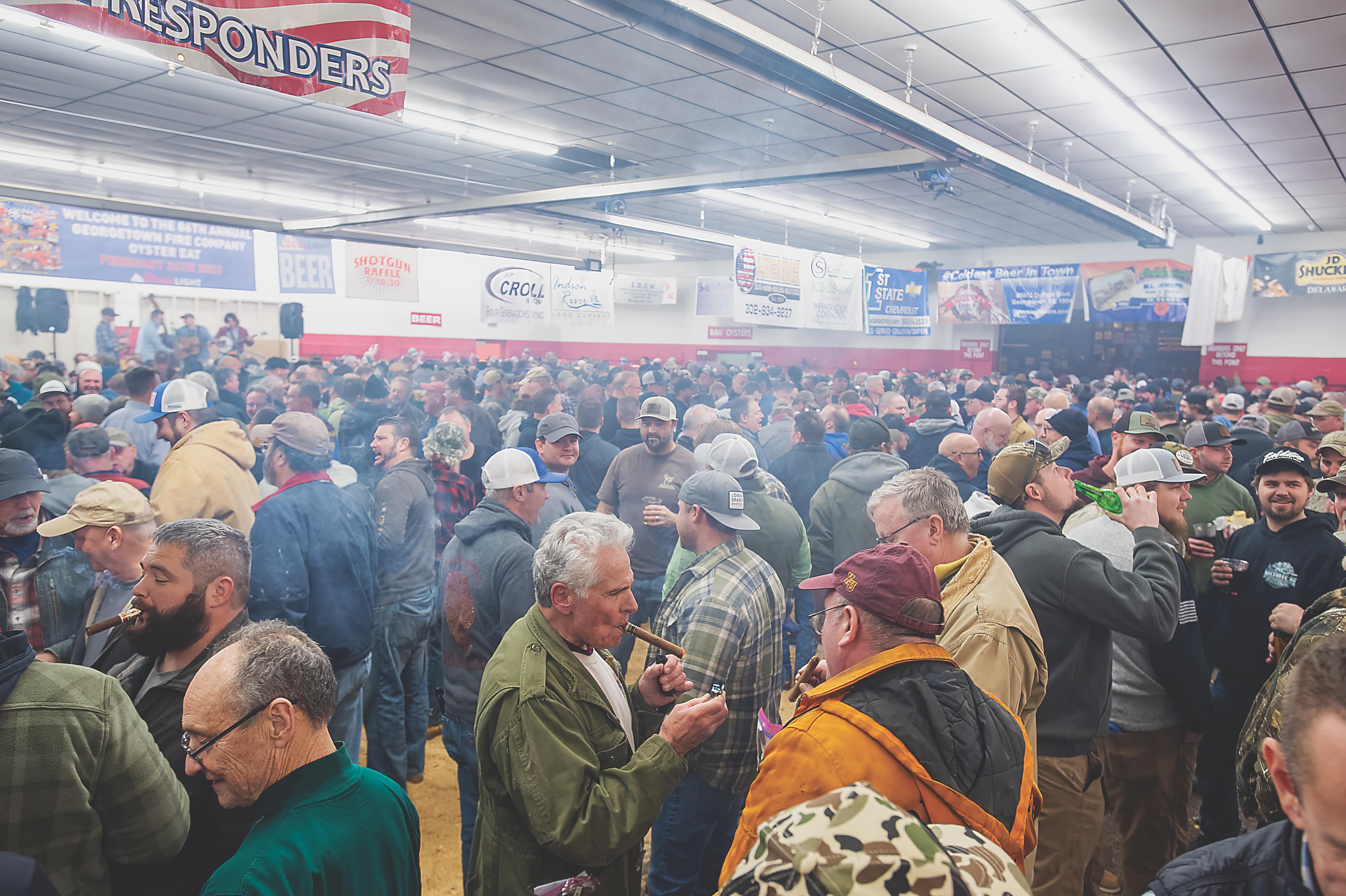
This annual winter fundraiser in Georgetown is one shell of a time
By Bill Newcott
Photograph by Scott Nathan
From the Winter 2023 issue

Table 3 is waiting for more oysters. A dozen or so men in ball caps and sweatshirts are shuffling anxiously from foot to foot, most of them fidgeting with the handles of the short, rounded knives they clutch in their hands.
A few puff impatiently on cigars. The thick smoke curls toward the ceiling of the Georgetown Fire Company garage, churning into a growing cloud fed by countless more fat cigars and glowing cigarettes in this enormous, but closed, space.
Some 800 men are crammed into the firehouse, and a lucky hundred or so have spots at the eight 10-foot-long oyster shucking tables: rustic, rectangular wood affairs, slathered with generations of green paint. A shelf rises in the middle of each one, topped with containers of ketchup, vinegar, hot sauce, salt and black pepper.
Also up there are bags of oyster crackers, which I’d always assumed were named that because they look like little oysters. Not so, it turns out: They happen to be a traditional oyster side dish and frequent ingredient in oyster stew.
Just five minutes ago, running men carrying metal cages and yelling “Hot stuff!” had hurled loads of oysters across the surface of the tables, sending the steamed shells skittering from one end to the other. Like bearded, starving seagulls, the waiting men had lunged upon them.
With savage intensity, they’d used those knives to pry open the shells. Then, with one skilled, swift move, they’d cut the slimy resident oysters loose. Finally, each man had either deposited the steamed remains into a paper bowl and doused them with a selection of fixings from the shelf — or simply popped the oysters directly into their mouths, one at a time. Either way, the approach ended the same way: With each man throwing his head back to let the things slip down his waiting gullet.
But that was, like, minutes ago. Most of the empty oyster shells have long since been deposited down a slot in the middle of the table. Now, aside from a slick, shiny layer of goo, the table is clear, awaiting the next batch.
The men at table 3 have their eyes focused beyond the milling crowd. They’re watching a line of stainless steel steamers in the back room, behind a line of tables. An aproned crew, well aware of the growing anticipation out there, is watching a clock, counting down five minutes. To the second.
A lid is thrown open. A cloud of steam rises, and so does a chorus of cheers from the waiting assembly. In moments, the men with the metal cages are again on the run.
“Hot stuff!” they holler, weaving their way through the mob of mingling men. “HOT STUFF!”
The shells clatter. The knives flash. And, at least for another five minutes, all is well.
It is fair to say there is nothing quite like the Georgetown Fire Company Oyster Eat — a fundraising event that’s been declared a Local Legacy by the Library of Congress Folklife Center. The firefighters of Georgetown have been sacrificing oysters on the last Friday of every February since 1933 — except for the four years of World War II, which means that 2023’s 86th annual eat actually marked the event’s 90th anniversary.
“It started out as a get-together for the local farmers,” says Sean Magee, a volunteer firefighter and co-chairman of the Oyster Eat. “Just a way for them to kick off the spring growing season.”
There’s scant information about that first gathering. But as I look across the room tonight, I think, it’s a sure bet those Georgetown area farmers did not consume 130 bushels of oysters and, seemingly, enough beer to cover the Indian River Bay with a thick, foamy head.
Guys have been lining up outside the firehouse on South Bedford Street since this afternoon. Needless to say, beer has been consumed on the sidewalk.
Shortly before 8 p.m., Magee takes a microphone and addresses the large volunteer staff.
“Be nice to our guests,” he advises. “And don’t run over anybody when you’re running steamers to the tables.”
A four-piece bluegrass band — the Keystone Mountain Boys — times its first guitar licks for the moment the doors open. First in are the die-hard oyster shuckers, who’ve waited all day to make damn sure they’ll get a spot at one of those tables. For the next hour there’s a steady stream of guys pushing through, slapping one another on the back, laughing heartily, bellying up to the beer tables (where a crew diligently keeps hundreds of cups full all night), and filling out raffle tickets for a shiny new shotgun (drawing at 10:30).
Dozens of men are hovering near the eight green shucking tables, waiting for an opening. Every once in a while, in a show of goodwill, one of the busy shuckers will turn and offer a just-opened shell to a standby guy. Usually, the offer is waved off. Oyster Eat is, it’s clear, not just about the eating.
Indeed, there are more than a few men who seem not so much interested in the oyster part of the evening as they are in simply hanging out with a bunch of fellow males, present here in a concentration that is vanishingly rare these days. The Georgetown Oyster Eat is, emphatically, an event for men — although it’s understood that a few women will inevitably show up and be perfectly welcome. (At this moment, about 15 miles away, the Lewes Fire Department is holding its women-only Shrimp Feast, an event started more than 30 years ago in response to the men’s event.)
Fully half the floor space of the firehouse is occupied not by shucking tables, but by open space where the men cluster in small groups, or pair off, leaning toward each other, shouting over the music and the general din that comes with 800 people trying to be heard. Everyone, it seems, is holding at least one beer; the amount of smoking going on takes me back to the 1960s-era Catholic War Veterans parties my dad used to host in New Jersey.
For those not part of the oyster shucking in-crowd, raw oysters on paper plates are served at a window. I stare embarrassingly as one bearded raw bar enthusiast pours hot sauce and ketchup on his oozing feast.
“Does that stuff enhance the flavor of the oysters,” I ask him, “or cover up the flavor of the oysters?”
He looks at me like I’m crazy.
“Oysters don’t have any flavor,” he says, and turns away.
Of course, oysters aren’t for everybody (like me, for instance). I find my way to a window where two volunteers steadily replenish a supply of foil-wrapped hot dogs, hard-boiled eggs and cold egg salad sandwiches, served in white paper envelopes. The hot dogs are, surprisingly, hot.
It’s already crowded an hour after the doors opened, and new arrivals continue to stream in. Most have prepaid tickets; some shell out their $40 on the spot.
By the time 10 p.m. rolls around, it’s getting a little hard to breathe in here. By Magee’s reckoning, this is the moment when the crowd reaches its apex.
“There’s an 8 p.m. crowd and there’s a 10 p.m. crowd,” he explains. “At about 10, the first group begins to give way to the second one.”
The hour also brings the second-biggest moment of the night (after the arrival of the oysters): The oyster knife auction. State Sen. Dave Wilson (R) — and call me crazy, but I suspect most of the folks in this room would enthusiastically place an (R) after their names — leads the bidding, which escalates a lot faster than you might expect. It’s a really nice knife, with a swirly blue handle that resembles van Gogh’s “Starry Night.” And it’s mounted, along with a vintage duck decoy found in the Great Cypress Swamp, on wood cut from the barn where the first ox was roasted for Georgetown’s Return Day parade. (Held two days after every county election since 1812, Return Day features both winning and losing candidates in a sign of unity. Imagine that.)
So this one artifact embraces any number of coastal Delaware touchstones. Still, it comes as some surprise when Wilson declares, “Sold for $6,500!”
In theory, the evening’s third hour should signal a shift change at the green shucking tables, and for the most part it does. Still, there are a few shuckers — heads down, knives flying, cigars pumping smoke like factory stacks — who are clearly in it for the duration.
By now I’m beginning to pay attention to the firehouse floor — carpeted with a good inch of sawdust.
“It’s the same sawdust they use in the chicken houses around here,” says Magee. “We bring it in here a week ahead of time and turn the heat up so it’ll dry out. Otherwise, because sawdust is kind of moist, it’ll clump up.”
Only now it’s not just sawdust beneath my feet. Hours of tossed oyster shell contents, spilled beer and cigar spit have begun to take their lumpy toll. On the plus side, I’m thinking, after soaking up all those fluids there’s little chance the stuff will catch fire from all the flicked cigarette and cigar ashes.
Despite what Magee says, it seems to me that by 10:30 the crowd is still swelling. You still can’t get near the shucking tables, and you need to zig-zag twice the distance just to get across the room.
And then the dancing starts.
There’s been a lot of toe-tapping ever since the Keystone Mountain Boys first cranked up a few hours ago, but now — and I’m totally attributing this to the beer — a clutch of guys have started dancing at the foot of the bandstand. I use the term “dancing” solely as a point of reference, because I can discern no particular step, nor do the movements seem to be particularly in time with the music. Instead, I am reminded of the faithful at a Pentecostal church: eyes closed, feet stomping indiscriminately, arms waving, smiles of transcendent bliss.
Then again, none of the worshipers I’ve encountered on the revival meeting circuit ever managed to do all that while holding a beer in each hand and without spilling a drop — which I suppose is some sort of miracle in itself.
The Keystone Mountain Boys are red-hot now, clearly drawing energy from the dancers at their feet. They tear into a rousing rendition of the country classic “Rocky Top.”
“Spoons!” someone yells, and for a moment I think someone over at the shucking tables is calling for flatware. But no: Upon that order, a tall fellow with a close-cropped, flat-topped haircut produces from his breast pocket an honest-to-goodness set of musical spoons. In a flash he’s rattling them against his arm, his legs, his chest; perfectly matching the band, beat for beat.
But there’s more to the spoon ritual. One by one, the dancers bow and present their heads to the spoon man, offering themselves as playing surfaces. The spoon man obliges, moving from one noggin to the next, like Cream’s Ginger Baker working his whole drum kit on “White Room.”
By 11 p.m. there is a distinct thinning of the ranks. There are actually vacancies at some of the green shucking tables, although the periodic calls of “hot stuff” followed by the rocky roll of oyster shells has not slowed one bit.
“We’ve had about 800 here tonight,” says Magee. That sounds mighty good to me, but it’s down about 200 from the average. “I would like to have seen a thousand here,” he says.
Then, he adds, “We’ve had as many as 1,200, and I can tell you, that’s no fun.”
Man, I’m thinking. What would the fire marshal think of 1,200 men, packed like oyster-eating sardines, smoking and drinking in here? Then I remember: Oh, yeah — the fire marshal is probably here. Slurping down oysters.
Despite the lighter-than-hoped-for turnout, it’s been a good night for the Georgetown Fire Company’s fundraising effort. They’ve taken in $32,000 in ticket sales, plus $16,000 from sponsors, plus that $6,500 for the tricked-out oyster knife, plus money from the shotgun raffle — all of which will help cover the company’s operating expenses.
And there’s something else, just as important: As Magee scans the crowd of guys having the time of their lives — until this February, anyway — he also sees an opportunity to recruit new firefighters for the company.
“We need volunteers,” he tells me. “Every fire company in Delaware needs volunteers. Not just firefighters, but support workers, too.”
For Magee, whose family has worked their farm near Selbyville since 1865, volunteering was a natural consequence of being a native Delawarean. But as residential development has exploded in the past decades, it’s been hard to keep up solely through the historic my-family-has-always-been-firefighters tradition.
“Until the last five years, recruit-ment in Delaware was always kind of passive,” he says. “Now we’re actively getting out there. There are even some benefits: a tax credit, a beach tag, tuition reimbursement.
“Volunteer fire companies save Delaware about $240 million a year. And events like this help people understand that.”
It’s almost midnight. The band is singing the old Roy Acuff tune, “Traveling the Highway Home,” a not-so-subtle suggestion that it’s time to move on. As two of the station’s large garage doors slowly rise — dropping hunks of sawdust as they do — a few stragglers frantically shuck the few remaining oysters.
“You can’t just leave ’em,” one guy tells me as he slips his knife between the halves of a remnant shell.
The cold night air floods the room, and the exodus out those large doors begins. Now a crew of company volunteers, in firefighting outerwear, file in from the back. They begin peeling away the thick brown paper that each shucking table has been wearing as a skirt — revealing the mounds of oyster shell carnage below.
One by one, the crew starts flipping the tables over. Oysters, beer, cigars, hot dogs and egg salad tumble to the sawdust — yielding a pervasive scent that can only be described as a combination of, well, oysters, beer, cigars, hot dogs and egg salad.
“Beep … beep … beep …” Above the rumble of a diesel engine, the backup signal of a Blue Hen Disposal truck sounds as the vehicle pokes its business end through one of the station doors. Then, lurching into action, a small yellow front loader sprints in and sets to work scooping up the remnants, depositing them in the garbage truck.
The party is, indisputably, over.
It’s chilly outside the Georgetown Fire Company, and a line of well-partied guys are sensibly boarding a school bus that someone has rented for the occasion. Others are drifting off on foot in all directions: some north and south on Bedford Street; others east and west on Pine.
As I head down Pine Street toward my car, I overtake two plaid-shirted fellows who are valiantly attempting to navigate a straight line down the sidewalk.
“Do you guys need a ride?” I ask, failing to take into consideration the possible consequences for my Honda Civic’s interior.
They look at each other and smile.
“Ahh, we’re good,” one says.
They continue on, each with one hand on the other’s shoulder, passing from the glow of a streetlight and disappearing into the night.



